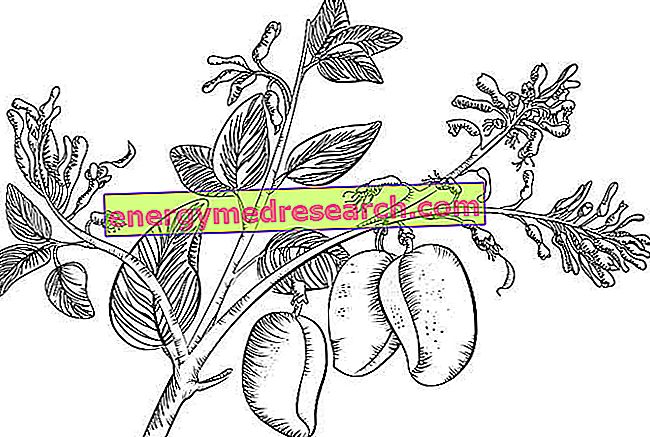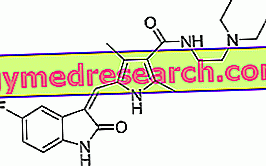What is that
Griffonia - whose scientific name is Griffonia simplicifolia - is an evergreen plant belonging to the Fabaceae family, native to central-western Africa.

Known and particularly appreciated for the content of 5-hydroxytryptophan (or 5-HTP), the griffonia extracts are used in food supplements whose use is mainly indicated in case of lowering of mood and insomnia. This is because the aforementioned 5-HTP is an intermediate in the synthesis of serotonin, one of the main neurotransmitters involved in the regulation of mood, sleep and even appetite.
Features and Composition
Brief Description Botany and Chemical Composition of Griffonia
Griffonia is an evergreen climbing shrub, whose stem can reach three meters in height. The flowers are greenish in color and the seeds are enclosed in pods with a reddish-green color.
Seen the place of origin of the plant the shape of the seeds and the pods, the griffonia is also known with the name of " African bean ".
The plant's drug consists precisely of the powdered gray-brown seeds, from which the active ingredient 5-hydroxytryptophan is extracted.
In addition to 5-HTP, griffonia seeds also contain other indole-type substances, such as indol-3-acetylaspartic acid and 5-hydroxy-3-indolacetic acid (or 5-HIAA).
Properties and Effects
Properties of Griffonia and Mechanism of Action of 5-HTP
The properties ascribed to griffonia are mainly attributable to the 5-hydroxytryptophan contained in it. This compound, in fact, is an amino acid and metabolic intermediate in the synthesis of serotonin, carried out starting from the amino acid tryptophan.
Serotonin is a very important neurotransmitter for the well-being of the organism, as it is involved in many biological functions, among which we recall the mechanisms of mood, sleep and sense of hunger.
The oral intake of griffonia extracts titrated and standardized in 5-HTP, therefore, has the potential to increase serotonin levels in the central nervous system. Furthermore, it appears that, following the oral intake of the aforementioned compound, it is also possible to see an increase in the levels of other neurotransmitters, such as melatonin (very important in the regulation of the sleep-wake rhythm), dopamine, noradrenaline and beta-endorphins ( substances also involved in numerous biological functions, including sleep regulation and appetite control).
Given the actions that 5-HTP is able to carry out centrally, it is believed that griffonia is able to counter:
- The lowering of mood (in this regard, the plant is part of the large group of natural antidepressants);
- Insomnia ;
- Excessive appetite (particularly with regard to the desire for carbohydrates and sweets).
Moreover, thanks to the activities carried out by 5-HTP, griffonia extracts could also be useful in fighting chronic headaches and pain resulting from the fibromyalgia syndrome.
uses
Despite the different properties attributed to griffonia, its use has not obtained official approval for any type of therapeutic indication.
However, thanks to the multiple activities that 5-hydroxytryptophan has the potential to exert once ingested, griffonia - or rather the extracts obtained from its seeds - are widely used in food supplements whose intake can be useful in case of mood disorders, insomnia accompanied by agitation and to control appetite.
Warning!
The supplements are not intended as a substitute for a balanced diet and a healthy lifestyle.
Furthermore, it is important to remember that pathologies such as depression, insomnia and obesity are conditions that should not be underestimated and that certainly cannot be treated by taking a simple food supplement. In fact, griffonia extracts can be useful in non-pathological conditions, or possibly (if the doctor considers it necessary) can be used as adjuvants in the context of a specific medical-pharmacological treatment.
Uses of Griffonia in folk medicine
In African folk medicine, griffonia leaves are used to promote wound healing; while the juice they extract is used for the treatment of kidney disorders.
The bark, instead, is used for the preparation of poultices to be applied on syphilomas (lesions that appear in the initial phase of syphilis).
Finally, the decoction obtained from the stem and leaves of griffonia is used as a remedy against vomiting, against pelvic congestion and even as an aphrodisiac remedy.
Side effects
A very common side effect that can occur following the intake of griffonia extracts is nausea. Other side effects that can occur consist of vomiting, diarrhea and flatulence.
Furthermore, there is the possibility of allergic reactions occurring in sensitive individuals.
Pharmacological Interactions
Given the content of 5-HTP, the griffonia extracts are able to establish drug interactions with drugs, such as: carbidopa, monoamine oxidase inhibitors (MAOIs) and selective serotonin reuptake inhibitors (SSRIs).
Therefore, in the case of ongoing therapy with any of the aforementioned drugs, before taking products based on griffonia, it is necessary to seek advice from your doctor.
Pregnancy and breastfeeding
Since no adequate studies have been carried out on the matter, as a precautionary measure, the use of griffonia and its derivatives by pregnant women and breast-feeding mothers should not be carried out.
Contraindications
The use of griffonia, its extracts and the products that contain them, is contraindicated in individuals with known hypersensitivity to the same plant or to any of its components.



